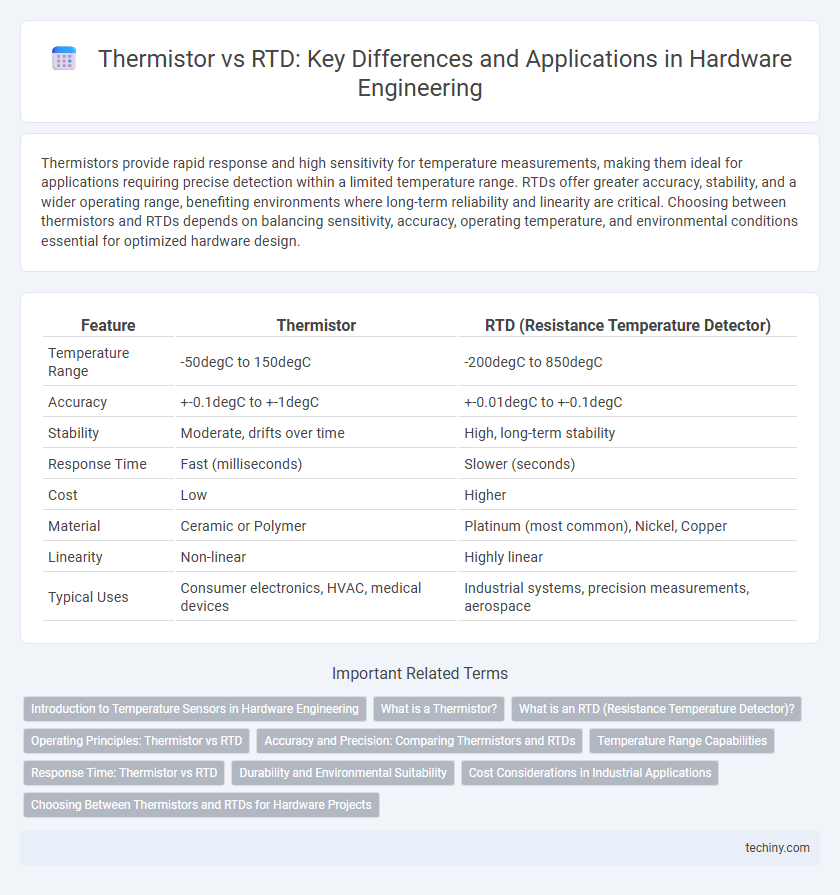Thermistors provide rapid response and high sensitivity for temperature measurements, making them ideal for applications requiring precise detection within a limited temperature range. RTDs offer greater accuracy, stability, and a wider operating range, benefiting environments where long-term reliability and linearity are critical. Choosing between thermistors and RTDs depends on balancing sensitivity, accuracy, operating temperature, and environmental conditions essential for optimized hardware design.
Table of Comparison
| Feature | Thermistor | RTD (Resistance Temperature Detector) |
|---|---|---|
| Temperature Range | -50degC to 150degC | -200degC to 850degC |
| Accuracy | +-0.1degC to +-1degC | +-0.01degC to +-0.1degC |
| Stability | Moderate, drifts over time | High, long-term stability |
| Response Time | Fast (milliseconds) | Slower (seconds) |
| Cost | Low | Higher |
| Material | Ceramic or Polymer | Platinum (most common), Nickel, Copper |
| Linearity | Non-linear | Highly linear |
| Typical Uses | Consumer electronics, HVAC, medical devices | Industrial systems, precision measurements, aerospace |
Introduction to Temperature Sensors in Hardware Engineering
Thermistors and RTDs are critical temperature sensors widely used in hardware engineering for precise thermal monitoring and control. Thermistors offer high sensitivity with a nonlinear resistance change, making them suitable for quick-response applications, while RTDs provide greater accuracy and stability across a broader temperature range through resistance changes in metallic elements. Selecting between thermistors and RTDs depends on factors such as measurement accuracy, temperature range, response time, and environmental conditions.
What is a Thermistor?
A thermistor is a temperature-sensitive resistor made from semiconductor materials, exhibiting a significant change in resistance with temperature variations. It provides high sensitivity and fast response times, making it ideal for precise temperature measurements in electronic circuits. Unlike RTDs, thermistors typically have a nonlinear resistance-temperature relationship but offer cost-effective solutions for temperature sensing in a range of applications.
What is an RTD (Resistance Temperature Detector)?
An RTD (Resistance Temperature Detector) is a precise temperature sensor that measures temperature by correlating the resistance of a metal, typically platinum, with temperature. RTDs offer high accuracy, stability, and repeatability over a wide temperature range, making them ideal for industrial and laboratory applications. Compared to thermistors, RTDs provide better linearity and durability, which is crucial for long-term temperature monitoring in hardware engineering.
Operating Principles: Thermistor vs RTD
Thermistors operate based on the principle of a semiconductor resistor whose resistance changes significantly with temperature, exhibiting either a negative temperature coefficient (NTC) or positive temperature coefficient (PTC). RTDs (Resistance Temperature Detectors) function by measuring the change in electrical resistance of pure metal, typically platinum, which increases linearly with temperature. The precise resistance-temperature relationship in RTDs allows for highly accurate and stable temperature measurements over a wide range.
Accuracy and Precision: Comparing Thermistors and RTDs
RTDs (Resistance Temperature Detectors) generally offer higher accuracy and precision than thermistors due to their stable and linear response over a wide temperature range, with typical accuracy levels around +-0.1degC. Thermistors provide excellent sensitivity and fast response times but tend to have nonlinear characteristics and less stability, limiting their precision to approximately +-0.2degC to +-0.5degC. For applications requiring exact temperature measurement and reproducibility, RTDs are preferred despite being more expensive and requiring complex signal conditioning.
Temperature Range Capabilities
RTDs typically operate within a temperature range of -200degC to 850degC, providing high accuracy and stability for industrial applications. Thermistors generally cover a narrower temperature range from -50degC to 150degC, suitable for precise measurements at lower temperatures. The choice between Thermistor and RTD depends on the required temperature span and application environment, with RTDs preferred for extreme temperatures and long-term reliability.
Response Time: Thermistor vs RTD
Thermistors exhibit significantly faster response times compared to RTDs, typically in the range of milliseconds to a few seconds due to their smaller size and higher thermal conductivity. RTDs usually respond slower, often taking several seconds to stabilize, because of their larger construction and the inertness of the metals used, such as platinum. This difference in response speed makes thermistors ideal for applications requiring rapid temperature changes detection, whereas RTDs are preferred for high-accuracy measurements over steady-state conditions.
Durability and Environmental Suitability
Thermistors offer high sensitivity but lower durability under extreme temperature fluctuations, making them suitable for controlled environments. RTDs provide superior durability with stable performance in harsh environments, including high temperatures, chemical exposure, and mechanical stress. Their robust construction ensures long-term reliability in industrial hardware applications requiring precision temperature measurement.
Cost Considerations in Industrial Applications
Thermistors generally offer lower initial costs compared to RTDs, making them attractive for budget-sensitive industrial applications. RTDs, while more expensive upfront, provide superior long-term stability and accuracy, which can reduce maintenance and replacement costs over time. Selecting between thermistors and RTDs involves balancing the lower price of thermistors against the enhanced performance and reliability of RTDs in critical industrial environments.
Choosing Between Thermistors and RTDs for Hardware Projects
Thermistors offer high sensitivity and fast response times, making them ideal for applications requiring precise temperature measurements within a limited range. RTDs provide superior accuracy, stability, and wide temperature range compatibility, which suits industrial hardware projects demanding long-term reliability. Selecting between thermistors and RTDs depends on factors such as the required temperature range, accuracy, environmental conditions, and budget constraints in hardware engineering.
Thermistor vs RTD Infographic

 techiny.com
techiny.com